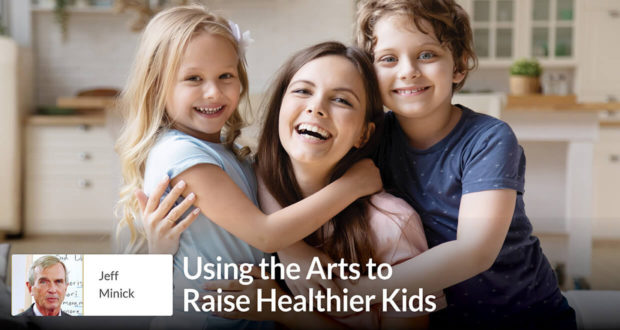Summary
Jeff Minick shows how art and music can strengthen the emotional health of our young people, arousing in them a sense of joy and an appreciation of beauty.Suppose you could augment your child’s religious education, boost their intellectual development, enhance their emotional well-being, and help salvage civilization all by embracing just two subjects?
It turns out you can.
The study of music and art in our home schools gives life to all these propositions.
For nearly two thousand years, the Catholic Church has acted as both the creator and the protector of the arts. Singers of Gregorian chant, writers of hymns, composers from Hildegard of Bingen to Palestrina, from Mozart to Henryk Gorecki, painters and sculptors ranging from Fra Angelico to Michelangelo to that ruffian Caravaggio: these and thousands of others left us a treasure house of religious art.
To study their works, to play their music and to model our painting and sculptures on their canvases and statues, can also increase the intelligence of our students.
But what about emotional health? Can the arts make an impact there as well?
Rest and Recovery
In an online article, The Science Behind Why Classical Music Is Good For Mental Health, we read that studies have shown that classical music can relieve stress and anxiety by lowering levels of cortisol, a stress hormone. Google “classical music emotional well-being,” and we find similar articles proclaiming the benefits of this music on mental health, blood pressure, and recovery from illness or injury.
Art can bring similar benefits when we contemplate a painting or sculpture rather than merely looking at it.
When we Google Moritz von Schwind’s A Player With a Hermit and then study this painting rather than merely glancing at it, focusing as does the painter on the weary minstrel seated outside a hermitage, like the minstrel we take a few steps out of this world and a few steps closer to heaven. We are reminded of the importance of rest and the need to escape the pressures of the world.
The Past Holding Hands With the Present
Just as important for our young people are the benefits of emotional intelligence and connections gained from the study of art and music. When they rest their eyes on Jean-Francois Millet’s painting The Angelus, for example, they may see a bridge between the prayers of this farmer and his wife, and our own recitation of the Angelus today. When they sing in their parish choir a centuries-old hymn or play the violin in an orchestra, they are connecting across the centuries with a culture that still speaks to them today.
In a world such as our present one, which so often seems broken, chaotic, boorish, rude, and disheveled, these links to the past through the magic of art and music can bring us solace, hope, and even joy. A toddler listening to the Hallelujah Chorus from Handel’s Messiah or to Tchaikovsky’s 1812 Overture may dance and bounce all over the living room floor, exhilarated by this magnificent music.
A 15-year-old girl may open a book of Norman Rockwell’s paintings and find herself mesmerized by the painter’s Girl at Mirror, feeling as if she herself is staring into a mirror, as if the painter has perfectly captured her discarding the dolls and crayons of the nursery and the blossoming of womanhood.
At their best, then, the arts act as connectors of human beings. Both the automobile mechanic and the professor can stand before a painting such as Rembrandt’s The Return of the Prodigal Son or Dante Gabriel Rossetti’s The Annunciation, and be moved by what they see. Both can listen to Aaron Copland’s Fanfare for the Common Man or Carl Orff’s O Fortuna, and find themselves profoundly affected by the beauty and majesty of this music.
The Artist Within
If we broaden our definition of “art,” we see that this creative impulse is a part of our human condition. In the seminars I used to offer to homeschoolers in Asheville, North Carolina, there were artists galore: violinists, pianists, dancers, and poets. One girl made lovely jewelry, which she sold online, another built ornate gingerbread houses and entered them annually in the contest at the Grove Park Inn, and a middle-school boy carved figures of animals and people from pine.
We see this desire to create all around us. Our four-year-old sits at the dining room table, lips pursed, drawing a heart on his mother’s birthday card; our seventh grader composes songs and sings them in her church youth group; her older brother plays guitar and loves to belt out Johnny Cash’s Ring of Fire.
Faith and Joy
Finally, art and music can strengthen the emotional health of our young people by arousing in them a sense of joy and an appreciation of beauty. In his 1999 Letter to Artists, Saint John Paul II wrote, “Beauty is a key to the mystery and a call to transcendence.” Our young people—and the rest of us as well—need that key and that call to thrive in this world.
So introduce your children to the arts, and make it a joy, a playground, if you will, delighting the ear and the eye. Take them to museums and concerts. Listen to some classical music or bring home art books from your public library. When you are using the Seton school materials, take a few moments to look at the paintings and pictures you find there. Google the artist and see what other works are available online. If they are so inclined, sign the children up for piano, dance, or drawing lessons.
Catholic writers, religious and lay, are fond of the term “more fully human.” Prayer, the Corporal and Spiritual Works of Mercy, and the steadfast practice of our faith help make us more fully human.
And so do the arts.

 Seton Magazine Catholic Homeschool Articles, Advice & Resources
Seton Magazine Catholic Homeschool Articles, Advice & Resources
